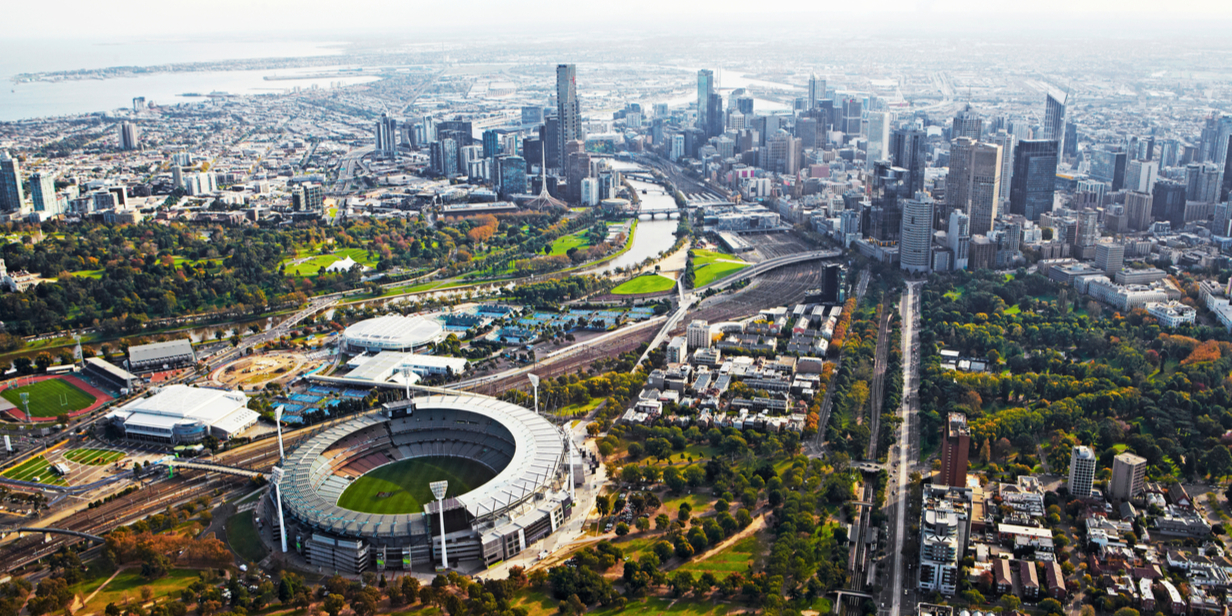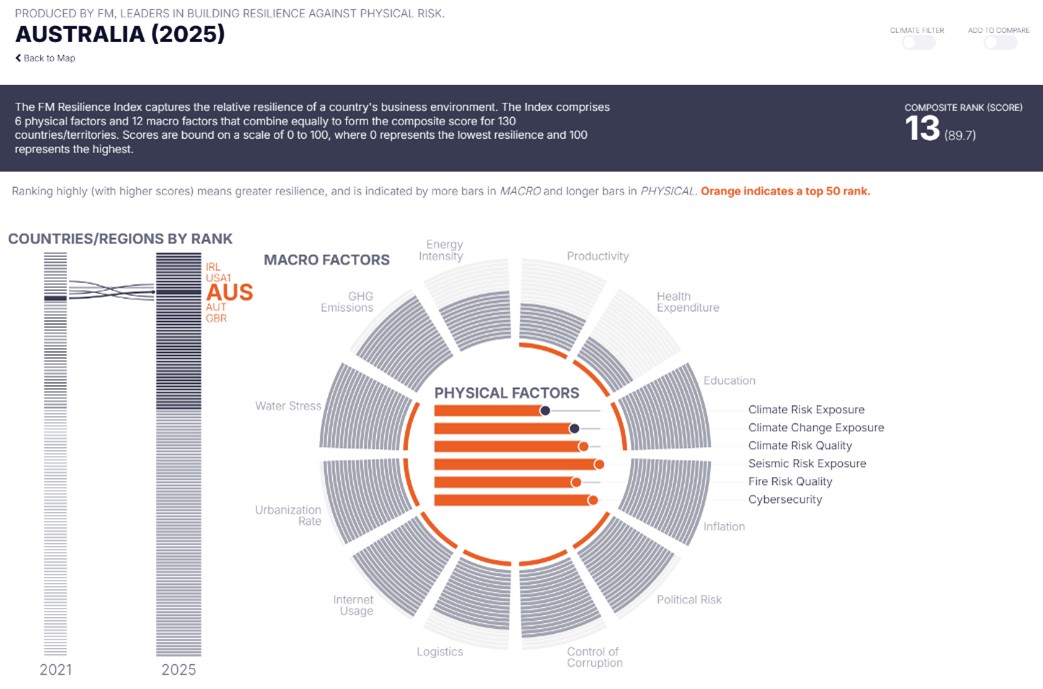Australia: The lucky (and resilient) country

In this series, we take a closer look at how key countries and territories ranked in this year’s FM Resilience Index. The FM Resilience Index is a tool developed to help understand a country’s vulnerability to disruptive events and its ability to recover swiftly, as well as which risks are manageable. The index provides a comprehensive risk assessment of 130 countries and territories.
Australia is famous for its stunning natural landscapes, unique wildlife, and laid-back lifestyle – but it is also known for a litany of risks, testing even the most intrepid among us. Deadly creatures, dangerous surf, unforgiving terrain – and those house prices. But what about risk to enterprise? How does Australia fare when it is measured for certainty to business operations, and how does it compare to its regional neighbours?
In a word? Well. Australia has demonstrated remarkable resilience, securing the 13th position, up from 14th in 2024. This annual survey, now in its 12th year, evaluates 18 categories of risk, providing a detailed snapshot of how nations are equipped to handle various challenges. Here’s a closer look at where the Lucky Country stood out.
It’s a Long Way to The Top
Australia's economic performance is a cornerstone of its resilience. The country ranked 21st in productivity, underscoring Australia's robust economic framework, which supports a high standard of living and a dynamic business environment. The nation's ability to maintain a competitive GDP per capita (12th globally) highlights more than its abundant natural resources; a strong service sector and continued investments in technology and infrastructure have been priorities of public policy.
Beds are Burning
Health expenditure is another area where Australia excels, ranking 14th globally. Medicare, first introduced in 1984, is an unbridled success, providing free or subsidized healthcare services to all Australian citizens and permanent residents. Investment in health is crucial for maintaining a healthy workforce and mitigating the impacts of health crises, and a strong private option helps relieve many of the costs.
Education is perhaps Australia's most impressive achievement in this year’s index, where it secured the top spot. This may even come as a surprise to many Australians and perhaps speaks to the quality they have come to expect. The data reflects Australia’s robust funding for education, along with a strong post-pandemic rebound with record numbers of international students. Australia’s universities in particular tend to punch above their weight in global rankings due to a number of factors including strong global research programs with skilled international faculty members, and consistently high student satisfaction.
Down Under
Despite these strengths, Australia faces significant challenges in other areas. The country ranked 67th in inflation, indicating a higher annual percentage change in consumer prices compared to many other nations. Rising interest rates, the high cost of labour and very high, seemingly unstoppable real estate prices (along with limited supply) have impacted economic stability and the cost of living, which can pose a risk to both businesses and consumers.

Energy intensity is another critical area where Australia lags, ranking 103rd. This metric highlights the country's dependency on energy per unit of productivity. High energy intensity can indicate inefficiencies and a greater environmental impact, suggesting a need for more sustainable energy practices. The rate of adoption of energy-efficient technologies and practices can impact energy intensity. While Australia has made strides in this area, there is still room for improvement in terms of widespread implementation of energy-saving technologies.
Great Southern Land
Australia's performance in environmental metrics presents a mixed picture. The country ranked 89th in greenhouse gas emissions, and while this isn’t a surprise with energy-intensive mining and manufacturing sectors, a vast petrol- and diesel-powered transportation network, substantive methane generation from its agriculture industry, and a general high standard of living, it does need addressing. Substantial public and private investment in renewables and more sustainable practices seem to be on the horizon, but the time to act is now.
As the driest inhabited continent, and with highly variable rainfall, water stress is another area of concern, with Australia ranking 31st, along with climate change exposure and climate risk exposure, two areas where Australia faces significant vulnerabilities, ranking 106th and 87th, respectively.
Approximately 70% of Australia's land area is used for agricultural purposes, making it highly susceptible to droughts, floods, and extreme weather events. The mining sector, concentrated in regions like Western Australia and Queensland, faces risks from cyclones and heavy rainfall. Coastal areas, vital for tourism and urban development, are increasingly threatened by rising sea levels and storm surges. Overall, a substantial portion of Australia's economic activities are vulnerable to the adverse effects of climate change and natural disasters, necessitating robust adaptation and mitigation strategies to safeguard the nation's economic stability and environmental health.
Somebody That I Used to Know
Australia's political landscape contributes positively to its resilience, with the country ranking 12th in political risk. This metric evaluates the perceived likelihood of government destabilization or overthrow by unconstitutional or violent means, including politically motivated violence and terrorism. The country has become famous for its world class electoral system, with preferential voting, easy access, regular 90%+ voter participation rates, and yes – democracy sausages – which now boasts its own Wikipedia page, and were devoured en masse at this month’s federal election. Control of corruption is another area where Australia performs well, ranking 10th in the world.
New Sensation
In the realm of technology, Australia ranks 25th in internet usage, indicating a high percentage of the population using the internet. This connectivity is essential for modern economies, enabling innovation, communication, and access to information. It’s a source of frustration for many Australians: along with strong mobile connectivity, they must make do with sub-par home broadband speeds, as the National Broadband Network (NBN) relies heavily on older technologies like Fibre to the Node (FTTN).
Logistics is a consistent strength, with Australia ranking 23rd. This metric assesses the ease of exporting to a target country, considering the quality of infrastructure, logistics activities, and public sector efficiency. Efficient logistics are crucial for supporting trade and economic growth.
Look What You’ve Done
Australia's urbanization rate, ranked 25th, reflects the country's balanced approach to urban development. The National Urban Policy was first introduced by Prime Minister Anthony Albanese in 2011; it aims to ensure that cities and suburbs meet the needs of both current and future generations, promoting social cohesion, economic growth and environmental sustainability. This approach helps Australia leverage its unique natural endowments and cultural history to create globally significant cities.
Fire risk quality is another area where Australia performs well, ranking 18th. This metric evaluates the quality and enforcement of building codes with respect to fire-based design, combined with the level of fire risk improvement achieved. Effective fire risk management is essential for protecting lives and property, contributing to overall resilience.
I Still Call Australia Home
It should be no surprise that Australia's performance in the 2025 FM Resilience Index highlights its strengths in economic productivity, health, education, and governance. The solutions to its inflation, energy intensity, and environmental risks however, are a work in progress, and with the incumbent federal party recently re-elected, Australians and the business community will be looking for these issues to be addressed - forthwith.
Australia has been actively transitioning from traditional industries like mining and manufacturing to embrace a more diversified and sustainable economic future. This shift is driven by investment in renewable energy, development of future industries, skills and training programs, and more. These efforts are positioning Australia to be a leader in the global transition to a net-zero economy, ensuring long-term economic resilience and sustainability. An anthem for all Australians to sing.
